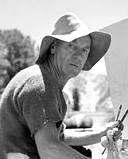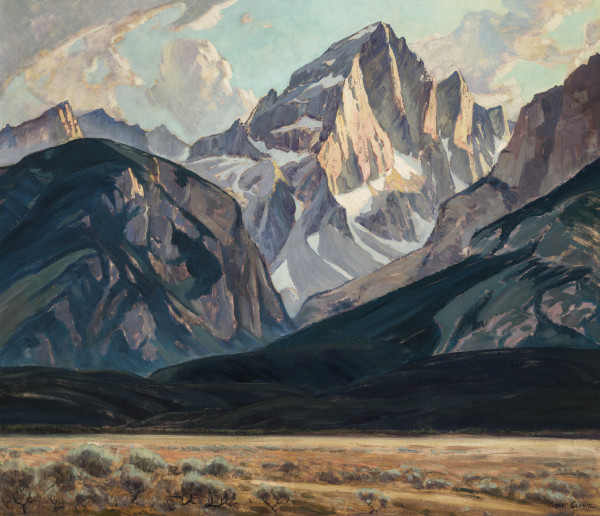
-
Artist: Robert Clunie (American (born in Scotland), 1895-1984)
“Robert Clunie was born in Renfrewshire, Scotland, the son of an estate gamekeeper and golf course designer. In 1911, Robert and his older brother William decided to emigrate to the United States, settling with relatives in Saginaw, Michigan. The remainder of their immediate family joined them in Michigan later that same year.” (1)
“In January 1918, wanting to escape the dark cold Michigan winters, Clunie boarded a train to Pasadena, California. It was on this return train trip back to Saginaw that he first saw, and fell in love with, the Sierra Nevada, taking the northern route over Donner Pass from San Francisco. By the end of 1918, he and his older brother drove to California.” (2)
"Arriving in Hollywood, Robert worked briefly at MGM painting film sets. When that work ended, he followed friends to the paint department of the American Beet Sugar Company in Oxnard. In 1919, Clunie married Myrtle Ireland of Santa Paula, where they bought a home not far from the city’s center.” (3)
“The Clunies became friends with other local artists, Cornelis and Jessie Arms Botke. Robert Clunie made his first trip to Lone Pine and the Sierra Nevada, Easter, 1928. He camped two blocks out of town on Lone Pine Creek. His first painting of the Sierra Nevada was of the Olivas Pack Station in Lone Pine. While on this trip, back at home in Santa Paula, the St. Francis Dam had collapsed. The Clunie home, built on high ground, was spared destruction by the floodwaters.” (2)
“In the summer of 1929, Clunie returned to the Owens Valley and spent eight weeks painting in the upper reaches of Big Pine Canyon. A local packer suggested a scenic knoll between Fourth and Fifth Lakes. Clunie painted profusely, inspired by the magnificent landscape. Guests from upper Glacier Lodge stopped by his camp and were soon buying paintings from his easel. He sold all of his paintings and took orders for more.” (4)
“Although sales fell off dramatically after the stock market crash of 1929, Clunie continued to show with the California Art Club and the Painters and Sculptors Club. During the Depression he received commissions for dioramas at the California Exposition and State Fair in Sacramento. In 1935 he spent two months painting in Taos, New Mexico where his work received praise from Walter Ufer and Ansel Adams. As the Depression waned, Clunie resumed his months-long pack trips to the mountains, spending each summer from 1938 to 1941 in the Tetons and the summers from 1942 to 1966 in the Palisades Peaks of the Sierra Nevada.” (1)
“In 1945, Clunie bought a small parcel of land in Bishop from a local rancher who said ‘I don't know what you are going to do with that swampland.’ By 1948, the Clunie family moved into their new residence and art studio on the north fork of Bishop Creek where they lived until they died in the 1980s. Myrtle died in 1981. Clunie continued painting until his death in 1984. He and Myrtle are buried in Santa Paula next to her parents.” (2)
Reference
1. Mark Sublette Medicine Man Gallery Staff. Robert Clunie (1895-1984) Biography [internet]. Tucson, AZ: Mark Sublette Medicine Man Gallery [cited 2020 Jan 13]. Available from: https://www.medicinemangallery.com/robert-clunie-biography
2. Askart Staff. Robert Clunie (1895-1984) [internet]. [cited 2020 Jan 13]. Available from: https://www.askart.com/artist_bio/Robert_Clunie/3000/Robert_Clunie.aspx
3. Squarespace Staff. Robert Clunie (1895-1894) [internet]. [cited 2020 Jan 13]. Available from: https://static1.squarespace.com/static/57ad0e28d482e96d0a7c8ef1/t/5853037ff5e23103ff984805/1481835393281/Robert+Clunie+Biography.pdf
4. Coons Gallery Staff. Robert Clunie, Coons Gallery [internet]. Truckee, CA: Sierra Nevada Geotourism [cited 2020 Jan 13]. Available from: https://www.sierranevadageotourism.org/content/robert-clunie-coons-gallery/sie986728f3219ed2492
